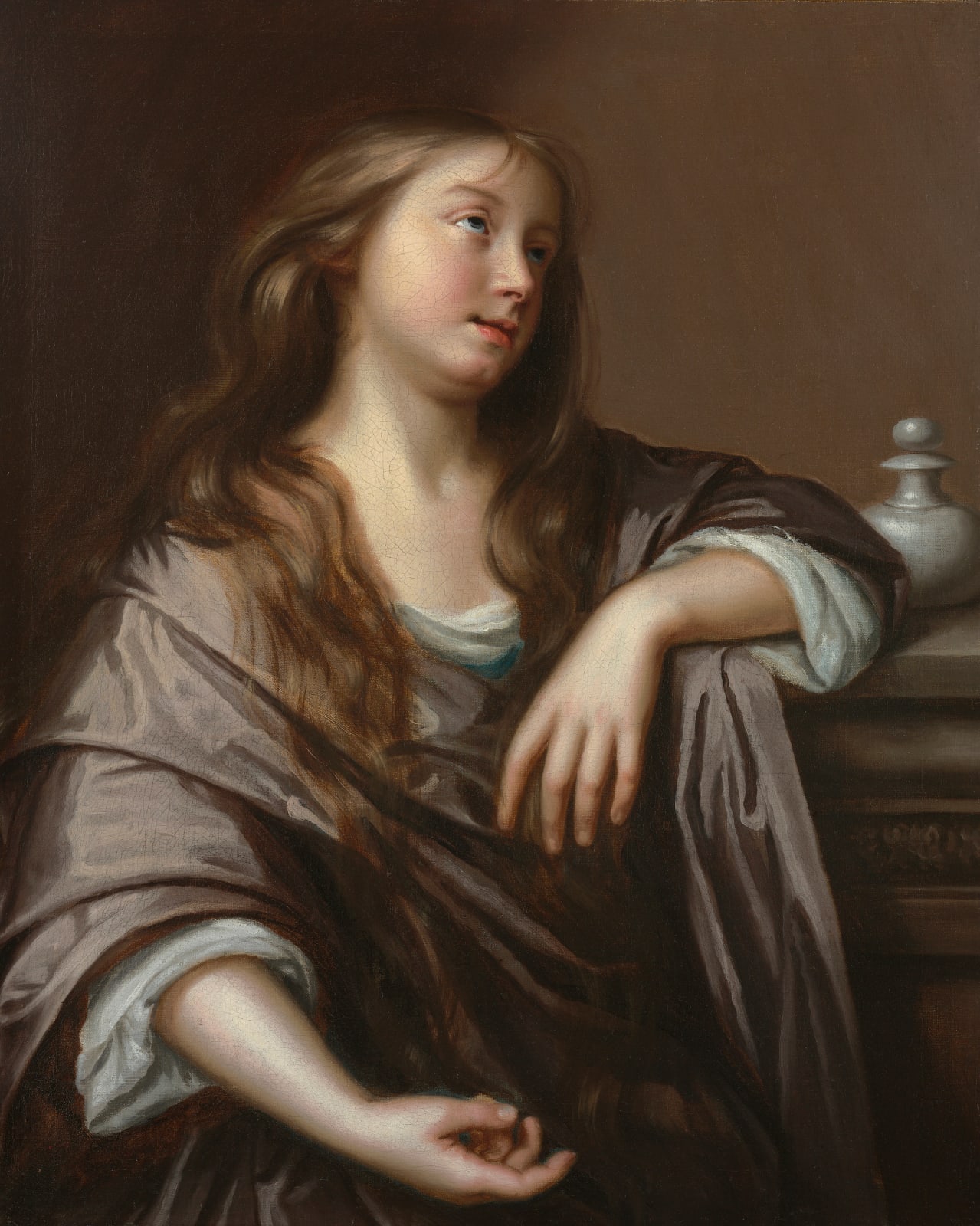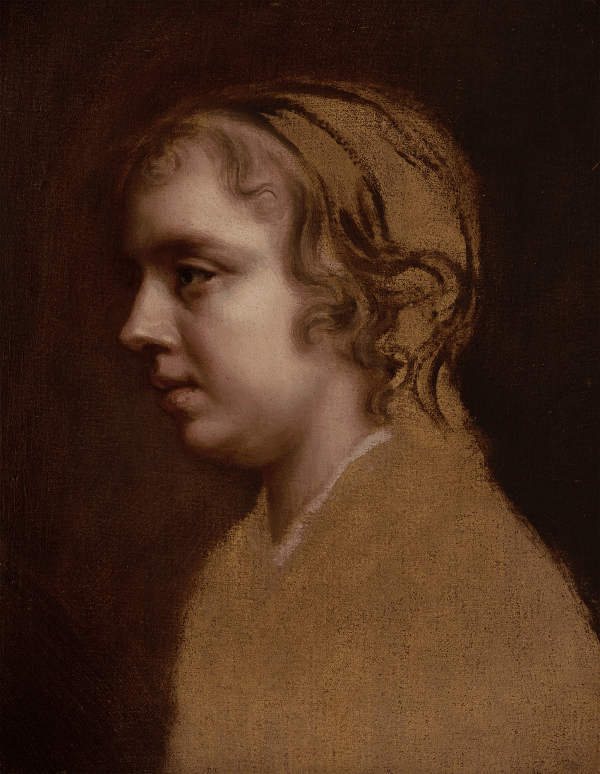
Mary Beale
The Penitent Magdalene, c. 1672
Oil on canvas
28 ½ x 22 ½ in (72.5 x 57 cm)
Philip Mould & Co.
To view all current artworks for sale visit philipmould.com
Although there is at present no known provenance for the painting, it must be the ‘Magdalen’ recorded by Beale’s husband, Charles, in his notebook as being painted in December 1672. In a note headed ‘pictures done from the Life by Mrs Beal since 1671/2’, Charles Beale lists ‘a Magdalen’. The art historian George Vertue then added in his transcription of Beale’s note; ‘a Magdalen painted from Moll Trioche – a young woman. she dyd 1672.’[1]
Moll Trioche must have been closely related to Keat, or Kate, Trioche, who was later one of Mary Beale’s models and studio assistants. An unfinished study of a young girl by Beale in the Tate (formerly with Philip Mould & Co.), painted c.1681, is thought to show Kate Trioche, and the two models seem to share a certain likeness. Vertue was seemingly mistaken about the year of Moll’s death, for, as the art historian Richard Jeffree noted, Moll actually died on 8th May 1674 (the same day Mary’s nephew, Bartholomew, committed suicide. for reasons which are unknown).[2]
The drawings in the British Museum which relate to this picture reveal one interesting fact about the circumstances in which it was painted. The first drawing shows the head of the same model in the same pose, and with tears falling from her eyes (a suitably penitential look). The second shows the same sitter, again in the same pose, but having fallen asleep. An impish bystander is inserting a small stick up the model’s nose. Evidently, Moll Trioche fell asleep during the sittings and this became something of a joke in the Beale studio.
The British Museum drawings were long thought to be by Mary Beale herself but recent scholarship has attributed them to Charles Beale. If the present painting is the ‘Magdalen’ described by the artist’s husband in 1672, then clearly the British Museum drawings, which are included in a volume inscribed at the beginning ‘Charles Beale/3d Book 1680’, must be copies by Charles (born in 1660) made after lost original studies by his mother.[3]
Mary Beale was the most distinguished female portrait painter of the Stuart period and enjoys a particular celebrity among the portraitists of the seventeenth century. This is not solely because she was a woman in a profession dominated by men, rather it was because she competed so successfully with her male colleagues and was so prolific a painter. Additionally, through the diaries kept by her husband Charles, a former Clerk to the Patents Office, who became her studio assistant and colourman, we know more of her technique and working practice than that of many of her contemporaries, including Sir Peter Lely.
The precise details of Mary Beale’s training remain obscure: her father John Craddock had been a member of the Painter-Stainers' Company and had had his portrait painted by Robert Walker in the late 1640s. Walker was then pre-eminent among painters in London, particularly in the puritan circles that included Mary Beale's family and it is, not unreasonably, supposed that Walker was her tutor in painting. In 1651 she married Charles Beale, a member of a prosperous family of Puritan gentry from Walton. Shortly afterwards the painter and her family moved to Covent Garden and began to associate with an erudite circle of artists, intellectuals and clergymen that was to provide the base of her patronage in later years.
Mary Beale’s painting remained an amateur interest until 1665, when Charles Beale lost his position at the Patent Office. After a five-year sojourn in the country – to escape the plague – the Beales’s returned to London and Mary established herself as a professional ‘Face-Painter’, and became the chief supporter of her family. The details of her work are familiar – thanks to the writing of her husband and to the remarkable number of her works that survive.
Beale’s strongest artistic supporter was Sir Peter Lely, Charles II’s court painter. The friendship between Lely and Mary Beale enabled her, famously, to observe the master in the act of painting – a remarkable privilege – in order to study his technique and she is known to have copied his work upon many occasions. She also enjoyed what appears to be a unique franchise to reproduce his portraits for sale in a reduced format, or, as she called them, ‘in little’.
Beale was also a gifted and intelligent writer, completing her ‘Discourse on Friendship’ [British Library] in 1667, in which she discusses at great length the meaning of the bond of friendship. Mary and her husband believed strongly in the concept of equality between man and wife, as evidenced by Mary’s ‘Essay on Friendship’. Without such equality, Mary believed, true friendship could not exist; ‘This being the perfection of friendship that it supposes its professors equal, laying aside all distance, & so leveling the ground, that neither hath therein the advantage of other.’
[1] The Walpole Society, ‘Vertue Note Books’, Vol. 24, 1935-6, (Oxford 1936) p.170.
[2] Charles Beale, Pocket book, 1672, with commentary by Richard Jeffree, circa 1975, National Portrait Gallery Heinz Archive, Richard Jeffree papers, drawer 2 folder 22; the pocket book transcript from George Vertue, 'Notebook A.x', circa 1740, British Library Add Ms 23072; in 'The art world in Britain 1660 to 1735,' at http://artworld.york.ac.uk.
[3] It may be, however, that we cannot rule out the possibility that some of the British Museum drawings are by Mary Beale.
Share
- X
- Tumblr

